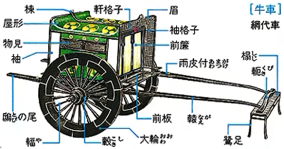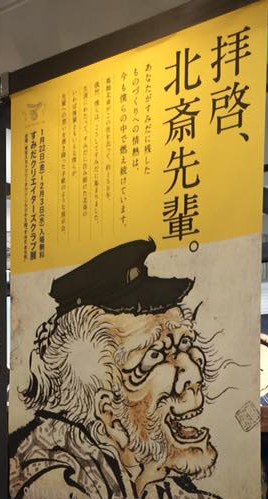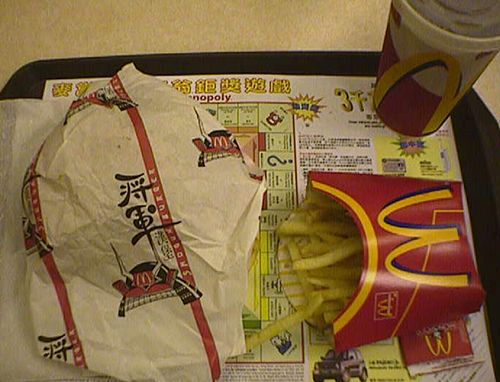159. The "Vehicle" Radical: 車
The 車 radical goes by three names in English: "vehicle," "cart," and "wheel." We'll call it "vehicle."
In addition to being a radical, 車 is an autonomous kanji:
車 (31: car, vehicle; train; wheel)
That character, says Henshall, is the pictograph of a "long-shafted two-wheeled chariot" as viewed from above. Wait, just two wheels? Wouldn't that be a bicycle? Ah, Henshall must be referring to an ox carriage, like the one in this image from Daijisen:

Oh! In all my years of perceiving 車 as a pictograph, I never imagined that it depicted anything remotely like this ox carriage!
Photo Credit: Eve Kushner
In Tokyo, there's a restaurant chain simply called 車 (くるま). The nine branches serve high-quality grilled chicken from Miyazaki Prefecture on Kyushu.
What Is the 車 Radical Called in Japanese?
Just as one can read the autonomous 車 kanji as くるま, that's the name of the radical, as in these examples:
軍 (466: armed forces; team)
輝 (1132: to shine; brilliant)
輩 (1688: peer; generation; successively)
We'll return to kanji 466 in a moment.
Photo Credit: Eve Kushner
I'm amused to see the "vehicle" radical on a vehicle (the back of a truck in Hong Kong)! I'm also amused that this company is called Glorious Ice, as the name includes the "fire" radical 火 in the second character. The company sells ice cubes. With that fire around, the ice would melt at once!
Here are the two Chinese words on the truck:
輝煌 (glorious)
雪粒 (very fine snow)
In Japanese, 煌 is non-Joyo.

Photo Credit: Meri Tojo
Our radical is the bottommost component in the largest writing here. We find 車 in 輩 (1688: peer; generation; successively).
In early 2016, at 東京ソラマチ (とうきょうソラマチ), a shopping center at the foot of Tokyo SkyTree, there was an exhibition about the famous artist Hokusai. The event included this sign, which said the following:
拝啓 (はいけい: Dear (so-and-so))
北斎 (ほくさい: the pseudonym of a famous artist, 1760–1849)
先輩 (せんぱい: senior), a respectful word used for one's elders
This exhibition was planned by Sumida Creators’ Club, a group of local creative people who apparently see Hokusai as their great forerunner. The 拝啓 北斎先輩 sounds as if the club wrote him a letter saying, “Dear Hokusai-senpai."
What's the Radical Name if the 車 Is on the Left Side?
When 車 is on the left side of a kanji, we can call the radical くるまへん (車編, meaning "車 on the left side of a radical"). Here are some examples:
転 (354: to rotate, revolve; fall down; undergo change)
輸 (799: to transport; ship; carry; convey; transfer)
載 (1295: to load (with cargo); place on; put in print)
Of the 15 Joyo kanji featuring the on-duty 車 radical, 11 have the radical on the left. You've already seen the four that don't, including the autonomous 車 kanji itself.
Photo Credit: Kevin Hamilton
Our radical appears three times in this photo, and it's even in two adjacent kanji! Here's what the writing means on each sign:
一時利用
temporary use
一時 (いちじ: temporary);
利用 (りよう: use)
自転車置場
place for storing bicycles
自転車 (じてんしゃ: bicycle);
置場 (おきば: place for something)
駐車料金は前払でお支払いください。
Please prepay the parking fee.
駐車料金 (ちゅうしゃりょうきん: parking fee);
前払 (まえばらい: prepayment); 支払う (しはらう: to pay)
The 一時利用 means that the bicycle parking facility is for one-time use, rather being rented out monthly or annually. The white sign is probably about bicycles, not cars, though people generally use 駐輪 (ちゅうりん) for parking a bike, not 駐車.
Why Is the 車 Radical in These Kanji?
It's not always obvious why 車 wound up in certain characters. Henshall clarifies that with etymological explanations for the following kanji.
軍 (466: armed forces; team)
The shape used to be different, representing a "vehicle with a protective encircling arm." That referred to "carts drawn into a circle to form a protected encampment," an ancient military practice. The circle of carts symbolized an "army," he says.
轄 (1090: control; linchpin)
Henshall says that 轄 "originally referred to a wedge-shaped linchpin inserted in the end of an axle to lock the wheel in place." Thus, 轄 came to represent "controlling element" and eventually "control."
軸 (1330: axis; axle)
Henshall says, in his newer edition, that 軸 combines 車 (vehicle) with 由 (reason, means). That right side contributes both meaning and sound, he implies, also conveying the associated sense “to stick out, project.” Together these two halves mean “center pole projecting out through wheel,” which is to say “axle.”
軟 (1673: soft; gentle)
This might be the most surprising place to find a vehicle! Henshall says that the character used to have a very different right side, one that meant "soft." That right side combined 而 (beard) and 大 (big), a beard being a symbol of softness. (Really?!) Originally, he notes, 軟 referred to the practice of "wrapping reeds around the wheels of a vehicle to soften the ride." (What an ingenious technique!) Later, 軟 came to mean "soft" in general.

Photo Credit: Lutlam
At McDonald's in Hong Kong, my proofreader bought a 将軍 (しょうぐん: shogun) burger. That sounds intimidating—unless you like eating samurai warlords! It was a teriyaki burger, so I suppose someone gave it a name meant to evoke images of Japan!
The word 将軍 breaks down as general + army.

Photo Credit: Eve Kushner
A sign at an Osaka-area izakaya (pub) features 運転 (うんてん: driving), giving us back-to-back instances of the 車 shape. As we've seen, 車 is the on-duty radical in 転. By contrast, the "movement" radical 辶 is on duty in 運 (which means "to control movement skillfully" in 運転, according to Halpern).
Here are the words in the sign:
未成年者 (みせいねんしゃ: minor)
飲酒 (いんしゅ: drinking alcohol)
飲酒運転 (いんしゅうんてん: drunk driving)
撲滅 (ぼくめつ: eradication)
So the authorities intend to eliminate underage drinking and drunk driving.
By the way, 運 (231: to transport; move skillfully; operate; luck; destiny) has an intriguing etymology. Henshall defines the 辶 as "movement" and the 軍 as "army." Some scholars interpret this 軍 literally, he says, so 運 means "army on the move," by association representing "transportation" and the "fortunes" of war. Other scholars feel that this 軍 acts phonetically to express "round," as well as "circle" and "vehicle" (from a circle of vehicles). If so, 運 means "vehicles rolling along" and therefore "transport."
